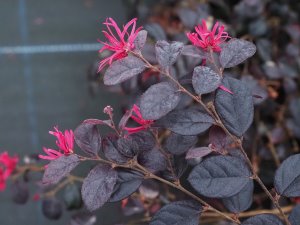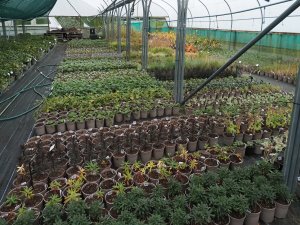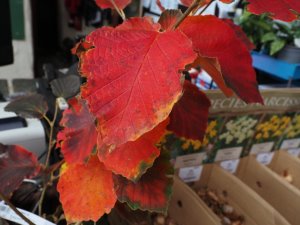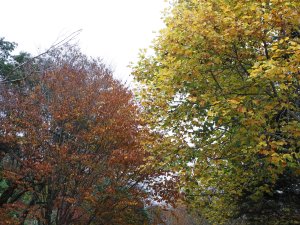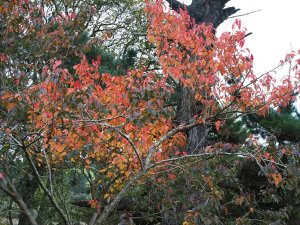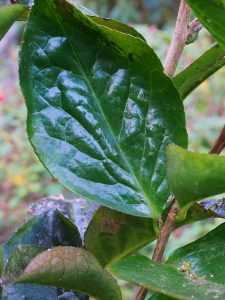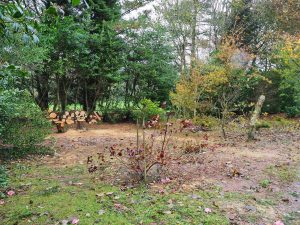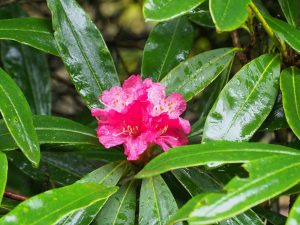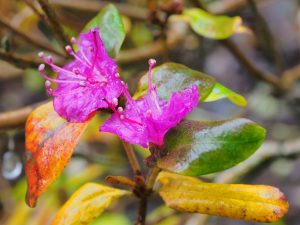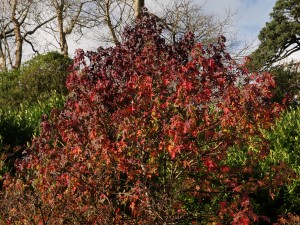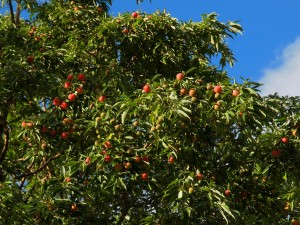2024 – CHW
A trip to Burncoose between the shooting days here.
The acers which arrived bare root from New Zealand, in only late July, are still in full leaf. Looking much better this year than 2 years ago. They will catch up on the seasons again by next spring.

2023 – CHW
The garden at Penvergate now tidied and ready for new tenants.
2022 – CHW
Camellia x williamsii ‘November Pink’ now nearing its best and already shedding many flowers in this exceptionally early flowering autumn.
2021 – CHW
The larger of the two gingkos outside the front arch is still fully green while the other (tucked away behind large Rhododendron ‘Cornish Red’) is properly yellow.
2020 – CHW
Collected a good crop of seeds from Camellia reticulata ‘Arch of Triumph’. A 25 year old plant with 15 or so huge seed pods which were just starting to split open but still had their seeds inside. The plant is growing in full sun beyond the Playhouse.
Visited Old Park and Forty Acres (without crossing the bridge in a vehicle) to view the sweet chestnut trees to be felled / deadwood/crowns removed with local tree surgeons. The Forestry Commission have issued a compulsory felling order to be completed by March 31st 2021. About a dozen trees to be felled and crowns/deadwood removed on a few more. I have written my views on this absurd and unnecessary destruction of elderly and dying trees earlier in this diary.
Jaimie is happily gathering more seeds (at Pam Hayward’s request) for the Rhododendron, Camellia & Magnolia Group seed list distribution to members. It is a poor magnolia seedling year generally but he found a few Michelia offerings, Liquidambar formosana and Platycarya strobilacea seeds before I moved on to look for more named Camellia reticulatas which might still have ripe seed. Asia had (again) beaten me to it on ‘William Hertrich’ which had all been gathered in and I found nothing else on any of the others. Retics need to be grown in full sun to have a chance of seeding properly. I must prompt Louisa to gather Camellia reticulata ‘Mary Williams’ which always seeds so well by the glasshouse at Burncoose and recheck our 1930s originals.
We have sent Lithocarpus seeds to our Belgian gardening friends who have so generously sent us new things last year. The diary earlier records Asia’s successes with three very rare new introductions to UK horticulture which came as seed from them last year. That is how gardening really works and always has amongst real collectors!
2019 – CHW
A sunny but chilly day and wet underfoot.
Enkianthus campanulatus ‘Wallaby’ with good yellow colour.



Overnight the champion Osmanthus yunnanensis has blown over in the garden. I think that if we pollard it and carefully upright the stem while digging in the roots it may yet survive and reshoot. It might even remain a champion tree by girth!
Camellia gigantocarpa is growing on rather well having looked a bit stunted for a few years after planting. No flowers yet (or signs of any) but new growth is now coming (dangerous) and the leaves become ever more gigantic. Certainly a plant to watch in the future.
Camellia sasanqua ‘Narumigata’ is full out with huge flowers that have pink outsides when in bud. This is the newer form sold by the nursery. The very old original plant on the top wall has much smaller flowers as we will see when it is out.
2015 – CHWLiquidamber styraciflua ‘Red Sentinel’ beside the drive is now at its absolute best. The top part of the tree is more purple than red but the odd remaining lower leaves are red. Marvellous in the sun today.
1934 – JCW
A long spell of dryish cold.
1933 – JCW
Just as in 1931 but it has been calm and warm for the most part.
1931 – JCW
No dracenas they are away.C sasanqua open, no other camellias yet the first blooms of cherry are showing in the quarry. A few rhodo’s give us a chance flower. Lapagerias are quite nice and the first Erica hybrida showed in Oct 3.
1922 – JCW
Fruit on Dracena very good. Lapagerias fair. No C sasanqua, roses nice, a late season but very fine, most of the leaves off, could do rot almost anywhere in the wood.
1911 – JCW
C sasanqua remains very good, useful lot of roses in the three beds, various daffs mainly with jonquil blood are up. Lapagerias nice, cassia stays on, solanum good, cirrhosa is coming out.
1900 – JCW
I picked a Camellia sasanqua, several were open. A Romneya coulteri open, and several fair roses. I see 131 has come through, seedlings with maximus blood are showing. Lapagerias very good. The cold N.E wind has come.








